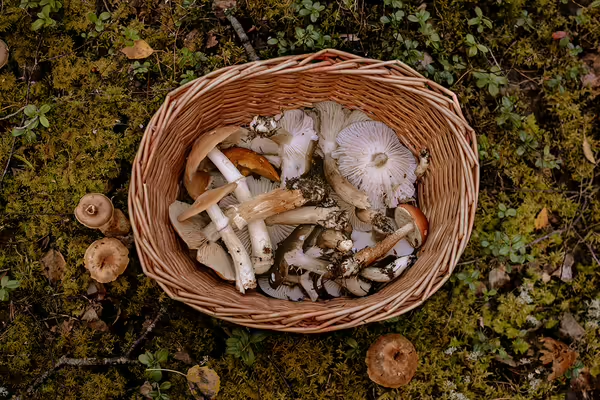
URBANA, Ill. — Every spring, enthusiastic woodland hunters scour forests across Illinois in search of an elusive and delectable fungi, the morel.
Determined foragers delight in the thrill of harvesting wild morel mushrooms, Morchella spp, that can’t be bought at a grocery store. Native mushrooms are incredibly difficult to produce due to a lack of understanding about the conditions needed to grow them.
“Wild morels definitely rule the spring, but there are quite a number of other edible mushrooms that can be found in Illinois, including pheasant backs, chicken-of-the woods, chanterelles, and my personal favorite, the hen-of-the-woods,” says Chris Evans, University of Illinois Extension forestry specialist.
Mushrooms are the fruiting bodies of larger organisms called fungi. Fungi typically grow as a dense mass of thread-like cells called mycelium. That mycelium collects energy and can produce mushrooms that release spores for reproduction.
“Think of a mushroom as the apple and the fungus as the tree,” Evans says. “If you ever pulled loose bark off of a rotting log, the white or light brown threads that fan out across the surface is part of the mycelium and is the main body of the fungus."
There are many different types of fungi, and not all of them produce mushrooms, but each is important to the health of native ecosystems by enriching the soil and rotting wood that creates homes for wildlife.
Fungi do not produce their own food through photosynthesis like plants. Instead, many attack and feed off other organisms growing on living trees, dead wood, or the soil.
“Many of our native plant species actually need the help of a fungus to grow,” Evans says. “These fungi will associate with the roots of plants to form structures called mycorrhizae that help uptake nutrients and transport water to the plant roots.”
Morels are saprophytic, meaning they get energy from dead organic matter. Some other saprophytic mushrooms, such as chicken-of-the-woods and oyster mushrooms, grow on dead wood.
Edible mycorrhizal mushrooms include chanterelles, which are some of the most common Illinois mushrooms in the summer, and truffles which compete with morels as being the most famous wild mushrooms worldwide.
Illinois is known to have three types of morel: yellow morel (M. esculenta), black morel (M. elata) and half-free morel (M. semilibera).
Where do you find morels? Long-time morel enthusiasts have their go-to spots, sometimes handed down for generations.
“We do know that morels start to pop up in forested areas as early as March in southern Illinois and typically follows in a matter of weeks across the state, all based on spring weather,” says Extension Horticulture Educator Ryan Pankau.
Those who plan to forage mushrooms hunt this spring should be sure to properly identify any fungi before consumption. Foraging should also be done safely and sustainably by treading lightly when off-trail. Many natural do not allow collection, so check ahead.
Allerton Park in east-central Illinois near Monticello is visited by mushroom hunters every spring.
“While the actual act of picking a morel may have little impact on woodlands, it’s the human disturbance that we worry about,” says Nate Beccue, Allerton Park Natural Areas Manager.
Sensitive vegetation is emerging along with mushrooms, and foragers may unintentionally harm other plants. Spring ephemerals wildflowers that grow in forests only have a small window of time to complete their life cycle before trees leaf out.
“Allerton’s rule is ‘stay on trails,’ which applies to any activity in the park,” says Beccue. “It’s meant to protect the one-of-a-kind resource we have.”
And if you don’t find anything on your quest for mushrooms, try another day.
“Don’t worry if morels aren’t magically popping out of the understory on your hunt,” Pankau says. “Any mushroom hunt is successful if I can observe nature on a nice spring day.”
SOURCES: Chris Evans, Forestry Specialist, University of Illinois Extension; Ryan Pankau, Horticulture Educator, University of Illinois Extension
WRITER: Emily Steele, Media Communications Coordinator, University of Illinois Extension
ABOUT ILLINOIS EXTENSION: Illinois Extension leads public outreach for University of Illinois by translating research into action plans that allow Illinois families, businesses, and community leaders to solve problems, make informed decisions, and adapt to changes and opportunities.
PHOTOS: Available for download: https://uofi.box.com/s/53970zukv4ovg5cra1juoh1ipqn7jrd7
